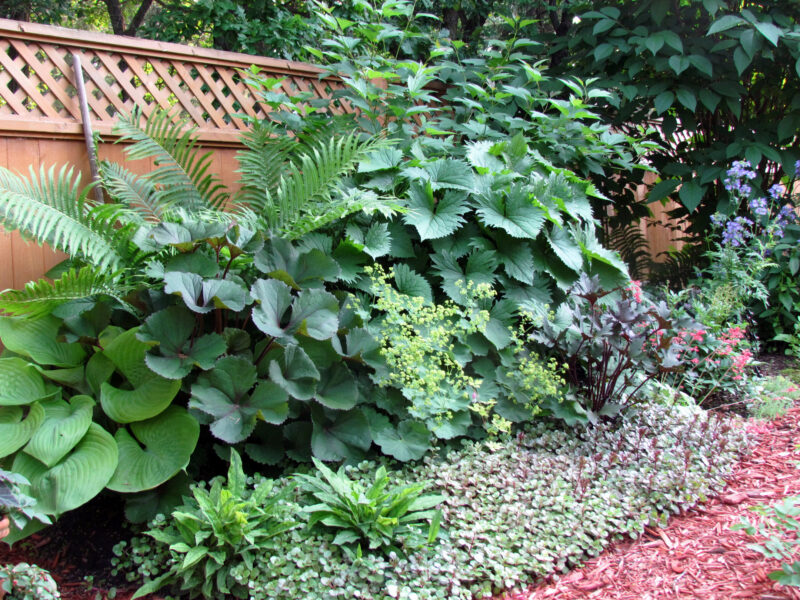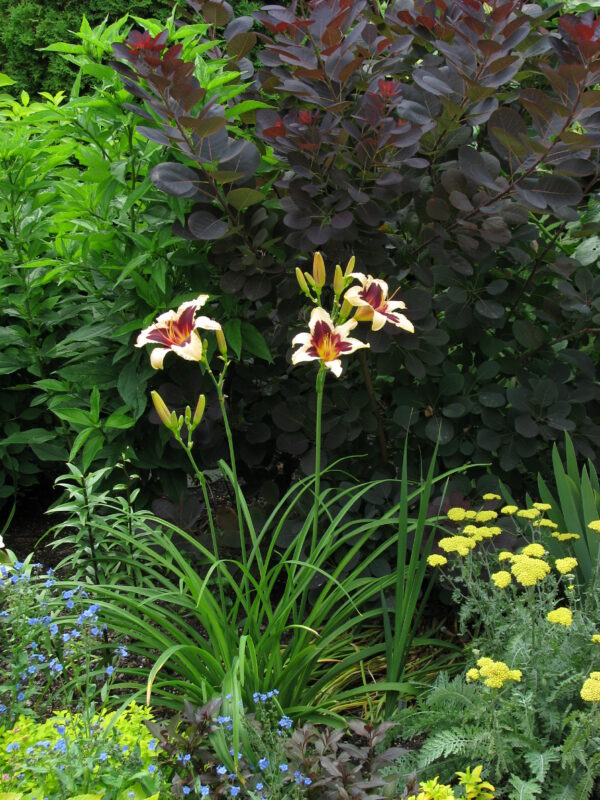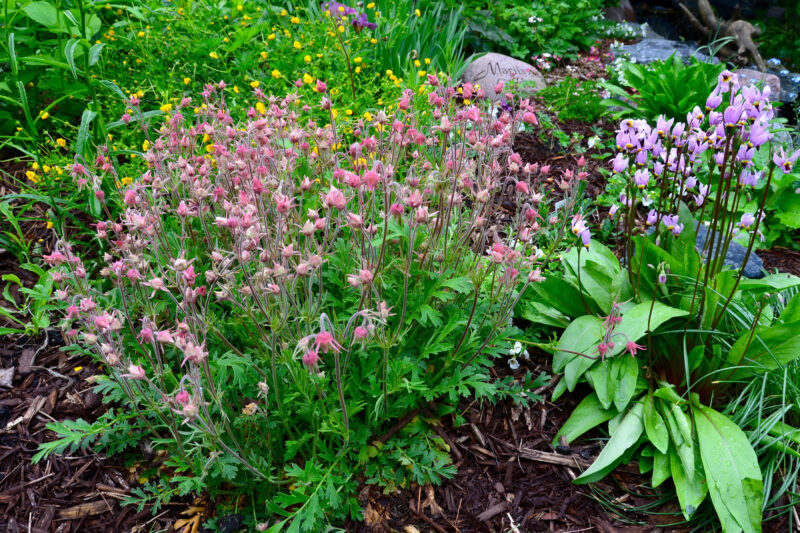Spice up your borders with dramatic textural contrasts
Plants with unusual characteristics spark interest and attention in the garden. As much as many of us recognize the value of simplifying our colour palette, limiting the number of species and cultivars, and emphasizing plant groupings in specific blocks of colour, an empty space in our gardens can be motivation enough to plant something unusual or unexpected.
Harmony doesn’t have to be sacrificed by incorporating one or a few individual specimen plants into your garden design. There is always an opportunity to draw on similarities in leaf or flower colour, shapes or textures. But also, garden design rules don’t preclude the sheer love of growing something new for its own sake. Call the addition of a specimen plant to your garden an architectural statement, a fresh approach or a focal point, if you will, but growing a plant that’s weird and wonderful as well as easy to grow can be very satisfying.
Roger’s flower

I fell in love with Roger’s flower (Astilboides tabularis) the first moment I set eyes on its distinctive form. Notable for its large shield-like leaves perched atop round, hairy stalks, Roger’s flower is Zone 3 hardy, suitable for damp shade, and grows to a mature height of 36 inches (90 cm). The cream-coloured, upright flower spikes resemble those of astilbe. Watching the hairy stalks as they emerge from the ground and the leaves taking shape in the spring is immensely enjoyable.
As the hairy stalks climb in height during the growing season, the olive-green leaves spread to an enormous, umbrella-like shape in the range of 24 inches (60 cm) across. High winds may result in spoiling one of the leaves by ripping a rounded edge. Choose a protected part-shade site with moist soil.
In spring, I protect the emerging stalks with a wire ring to deter rabbits, but once the plant grows, the ring is removed. I’ve moved Roger’s flower a couple of times to different locations in my garden and he has never protested.
Jack-in-the-pulpit

Jack-in-the-pulpit (Arisaema triphyllum) is another strange and fascinating woodland plant for shady, moist locations and requires minimal care. I often forget he’s growing in my garden until I spot the distinctive three-lobed leaves. Also known as cobra plant, jack-in-the pulpit with his mysterious hooded, striped flower, called a spathe, is far more than just a pretty face and most definitely a conversation piece. My lone specimen has survived for many years in dappled shade with moist, well-drained soil to which I add a generous amount of leafy mulch. Minimal disturbance is recommended, therefore this is one specimen that prefers to stay in one place.
Three varieties of ligularia

Combining cultivars of the same species that exhibit unique characteristics at different stages of their growth also sparks interest in the garden. On a visit to Doris McComb’s Winnipeg garden, I was struck by her skillful combination of three distinct ligularia cultivars – ‘Othello’, ‘The Rocket’ and ‘Osiris Café Noir’. Popular plants, each one of these varieties exhibits unique traits in both their flowers and handsome, diverse foliage. Richly black stems, dark green to deep purple leaves and extraordinary orange-yellow, daisy-like flowers make ligularia ideal specimens for sites in light to partial shade. ‘The Rocket’ has a tendency to wilt in the heat of the day, but typically recovers by evening.
Hands-down, ‘Othello’ is my favourite ligularia. The massive leaves are olive green with deep purple undersides, but what always intrigues me are the new leaves which emerge heart-shaped, ultra-glossy and purple-black. Then in August, prehistoric-looking pouches on thick, sturdy stalks open to reveal brilliant, long-lasting flowers. Ideally, ligularia deserves a moist location, but mine are planted in a thirsty bed that borders two massive spruce trees. No complaints so far although the mature size may be compromised somewhat.
‘Othello’ and ‘The Rocket’ are hardy to Zone 3, but ‘Osiris Café Noir’, a much daintier ligularia (23 inches/50 cm) with superb bronze-tinted, jagged-edged leaves, is hardy to Zone 4. An extra layer of protective mulch in late fall along with good snow cover should help to see it through the winter in cold-climate gardens.
‘Royal Purple’ smokebush

Cotinus coggygria ‘Royal Purple’ is, I think, a misunderstood specimen plant. Plant tags classify ‘Royal Purple’ smokebush as hardy to Zone 5, however, it readily survives Zone 3 winters so long as it receives reliable snow cover. Cold climate gardeners shouldn’t be deterred from growing it. True enough, your smokebush may die to the snow line, or even the ground after a harsh winter, but by June it starts anew and quickly assumes or exceeds the previous year’s growth.
An outstanding specimen shrub that asks for nothing more than a full-sun location, average soil, and moisture as needed, ‘Royal Purple’ smokebush features deep burgundy, rounded leaves and, if you’re fortunate, puffs of pinkish-purple, smoke-like seed clusters that double as flowers. Mine has yet to produce seed clusters. Nevertheless, the first time I saw smokebush was in Linda Dietrick’s Winnipeg garden and knew this was an enviable plant worth emulating. Dietrick’s specimen is shown off to perfection as a stunning backdrop to Hemerocallis ‘Wild Horses’, an attractive bi-colour daylily. She grows her smokebush in an area where it receives plenty of snow cover and prunes the branches to three to four feet (90 to 120 cm).
“It’s such a deep, saturated purple, and really sets off anything yellow,” says Dietrick.
Three-flowered avens

Three-flowered avens (Geum triflorum) is a spring-flowering native perennial that’s also known as old man’s whiskers or prairie smoke. Deer-resistant, it flowers May to June and is an excellent groundcover for sunny, dry areas. The pinkish stems grow to 15 inches (40 cm) tall. When I visited Marilyn Latta’s Winnipeg garden, I saw that she combined it with Saline shooting star (Dodecatheon pauciflorum). Interestingly, the leaves of shooting star, a perennial plant, do a disappearing act in August when the plant goes dormant, but reliably reappear the following spring. Dodecatheon, the genus name for shooting star, is an ancient name signifying “flower of the twelve gods.”
Groundcovers and other ideas
There are many distinctive groundcover varieties, too, that stand out from the crowd. Pussy toes (Antennaria parvifolia) hugs the ground with layers of velvety, silver-grey leaves. In late spring to early summer, tiny tufted flowers, reminiscent of cat’s paws, float above slender stems. Pussy toes is a food plant for American painted lady butterfly caterpillars.
There are so many unique plants to choose from which aren’t necessarily uncommon but offer an unusual quality. Consider Amsonia ‘Storm Cloud’, commonly called bluestar. This hardy herbaceous perennial is truly lovely with an abundance of tiny star-like, periwinkle blue flowers borne in clusters. But watch closely and you’ll observe that the flower clusters start out almost in the shape of feathery tassles. When the flower show ends, bluestar’s willow-like olive-green foliage transitions to golden-yellow in autumn.
Whether the show of impressive and unique plants is enjoyed by an audience of one or several visitors to the garden, it’s always fascinating to watch.

Leave a Reply